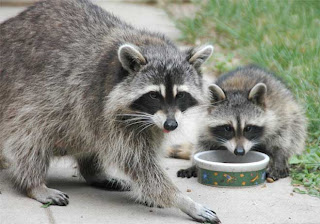True Wild Life | Raccoon | The raccoon is a medium sized bear-like mammal that was originally only found in North America. Due to the deliberate introduction of the raccoon into other countries, the common raccoon can also be found now in Europe and Japan. The average raccoon is around 70 cm from the raccoons nose to the tip of the raccoons tail. A fully grown raccoon can weigh up to 10kg and can live for up to 20 years in captivity. Raccoons in the wild however, tend to have a much lower life expectancy.
The raccoon originally inhabited densely wooded areas and large forests but today the raccoon has adapted to living in mountainous and wetter habitats. The raccoon has also moved closer to human communities as the raccoons are able to find food very easily but many homeowners consider them to be pests. Raccoons are grey, omnivorous animals surviving on a diet consisting of insects, plants and small animals such as fish and the occasional bird. Raccoons tend to be nocturnal but it is not uncommon to spot a raccoon during the day.
The most distinctive feature of the raccoon is the black mask found around the eyes of the raccoon. The raccoon has a thick layer of fur which keeps it warm during the cold winters and raccoons also have extremely sensitive and and dexterous front paws with raccoons having been observed turning door knobs and opening jars. Raccoons forage for their food and raccoons are often found close to water. Raccoons have been observed washing their food in water before consuming it! Although the reasons for this behaviour are not really known, it is thought that the sense of touch of the front paws of the raccoon is heightened when wet.
Their are around ten different species of raccoon that range in size but differ little in appearance, found throughout the Americas. The sense of touch is the most important for a raccoon and their agile front paws are covered in a spiny coating to protect them when they are not being used to aid eating. Raccoons tend to mate in the late winter to early spring from January to March. However, more southernly raccoon species have been known to mate later with the mating season often lasting until June. After a gestation period of around 2 months, the female raccoon will give birth to roughly 5 baby raccoons, also known as kits or cubs.
The raccoon kits are born blind and deaf, with both senses appearing with the first month. Baby raccoons are not born hairless but instead have a layer of light coloured fur, with the distinctive black mask being visible from birth. Raccoon kits are normally about 10 cm long at birth and weigh around 75 g.
You have read this article Least Concern /
Mammal /
Omnivore /
Raccoon
with the title Raccoon. You can bookmark this page URL http://kevinnicollecolvin.blogspot.com/2011/03/raccoon.html. Thanks!















No comment for "Raccoon"
Post a Comment